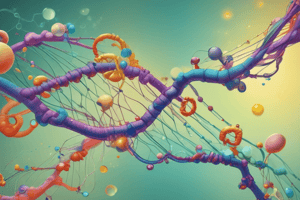Podcast
Questions and Answers
What is the correct flow of genetic information in the Central Dogma of Molecular Biology?
What is the correct flow of genetic information in the Central Dogma of Molecular Biology?
- DNA → mRNA → Protein (correct)
- DNA → Protein → mRNA
- RNA → DNA → Protein
- Protein → RNA → DNA
RNA is always double-stranded.
RNA is always double-stranded.
False (B)
What are the three main steps of transcription?
What are the three main steps of transcription?
Initiation, Elongation, Termination
The strength of a promoter determines the rate of __________ of the gene controlled by this promoter.
The strength of a promoter determines the rate of __________ of the gene controlled by this promoter.
Match the following components of transcription with their descriptions:
Match the following components of transcription with their descriptions:
What is the primary function of RNA polymerase II in eukaryotic cells?
What is the primary function of RNA polymerase II in eukaryotic cells?
Rho-independent termination involves a GC rich stem-loop structure followed by a run of A's.
Rho-independent termination involves a GC rich stem-loop structure followed by a run of A's.
What is the role of the 5' cap in mRNA processing?
What is the role of the 5' cap in mRNA processing?
The process of removing introns from eukaryotic RNA is known as __________.
The process of removing introns from eukaryotic RNA is known as __________.
Which of the following statements about eukaryotic promoters is true?
Which of the following statements about eukaryotic promoters is true?
What enzymatic complex is primarily responsible for catalyzing the splicing of introns?
What enzymatic complex is primarily responsible for catalyzing the splicing of introns?
What is the main purpose of adding a poly A tail to mRNA?
What is the main purpose of adding a poly A tail to mRNA?
Match the RNA polymerase with its transcription role in eukaryotes:
Match the RNA polymerase with its transcription role in eukaryotes:
Flashcards
Central Dogma of Molecular Biology
Central Dogma of Molecular Biology
The theory that genetic information flows from DNA to RNA to protein, or directly from RNA to protein. This process is directional and does not go back in the opposite direction.
Transcription
Transcription
The process of copying genetic information from DNA into messenger RNA (mRNA).
Template Strand
Template Strand
The single-stranded DNA that serves as a template for RNA synthesis during transcription.
Promoter
Promoter
Signup and view all the flashcards
Translation
Translation
Signup and view all the flashcards
Pribnow Box
Pribnow Box
Signup and view all the flashcards
Elongation
Elongation
Signup and view all the flashcards
Rho-independent Termination
Rho-independent Termination
Signup and view all the flashcards
Rho-dependent Termination
Rho-dependent Termination
Signup and view all the flashcards
Exons
Exons
Signup and view all the flashcards
Introns
Introns
Signup and view all the flashcards
5' Cap
5' Cap
Signup and view all the flashcards
Poly A Tail
Poly A Tail
Signup and view all the flashcards
Study Notes
Central Dogma of Molecular Biology
- The central dogma states that genetic information flows in one direction: DNA to RNA to protein.
- RNA can also be directly translated into protein in certain cases.
RNA Structure and Stability
- RNA is a single-stranded nucleic acid.
- RNA's backbone is made of alternating phosphate groups and ribose sugar.
- DNA is more stable than RNA due to its chemical properties and double-stranded structure.
Transcription
- Transcription is the process of copying DNA information into mRNA.
- DNA serves as a stable template for this process.
- Transcription occurs in three main steps: initiation, elongation, and termination.
- The process is always 5' → 3'.
- Template and non-template (coding) strands are relative to the gene.
Transcription Initiation: General Overview - Prokaryotes
- RNA polymerase binds to the promoter region.
- The promoter region (like the Pribnow box/TATA box) is not transcribed.
- Promoter strength dictates transcription rate.
- Strong promoters lead to high rates, while weak ones lead to low rates.
Transcription Elongation
- Core RNA polymerase carries out elongation by sequentially adding RNA nucleotides.
- A 17 base pair transcription bubble is maintained during elongation.
Transcription Termination
- Rho-independent: Termination involves a GC-rich stem-loop followed by a uracil run.
- Rho-dependent: Pause sites become termination sites with Rho factor presence.
Eukaryotic Polymerases
- Pol I transcribes ribosomal RNA
- Pol II transcribes protein-coding genes
- Pol III transcribes tRNA and other small RNAs
Eukaryotic Transcription Initiation
- General transcription factors and RNA polymerase II bind to the promoter.
- DNA unwinding occurs.
- The carboxyl-terminal domain (CTD) of RNA polymerase II is phosphorylated.
- The first 5-10 phosphodiester bonds are synthesized.
- RNA polymerase II and many general transcription factors are released.
Eukaryotic Promoter Elements
- TATA box: A promoter element similar to the prokaryotic Pribnow box, crucial for binding RNA polymerase II.
- Initiator Site: Another element that is bound by TAFs (proteins that bind to TBP) which further bind to the TATA box.
RNA Processing (Eukaryotes Only)
- Eukaryotic pre-mRNAs are larger than mature mRNAs.
- Introns (intervening sequences) are removed during processing, leaving only exons (expressed regions) for translation.
- Introns are removed by the spliceosome, a large RNA-protein complex. The spliceosome is composed of multiple subunits (U1, U2, U4/U6).
5' Cap
- Added immediately after transcription initiation.
- A 7-methylguanosine cap is added in a 5' to 5' linkage.
- Protects the mRNA from degradation and is essential for translation initiation.
Poly A Tail
- Added to the 3′ end of the mRNA.
- Not encoded in the DNA sequence.
- Assists in RNA transport outside the nucleus.
Alternative Splicing
- One gene can produce multiple proteins with varying functions due to alternative splicing.
Studying That Suits You
Use AI to generate personalized quizzes and flashcards to suit your learning preferences.




